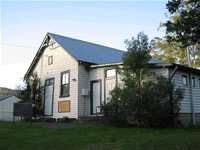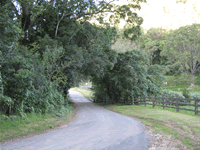|
|
Located about 90 km from Sydney Wyong is the administrative centre of the Wyong Shire. Its central location makes it an ideal starting point for exploration of the coast, with the beautiful Yarramalong Valley and state forests to the west and easy access to the coastal attractions and Gosford to the east. The first recorded european settler of the area was the headmaster of Sydney's first public school, William Cape, who received a land grant of 1000 acres near Jilliby Creek in 1825, to the west of Wyong. Cape was assigned a convict to assist him in preparing in his grant for use and remained in Sydney until 1827 when he chose to concentrate on his already extensively improved grants. He was lamed in an accident in 1828 and reputedly remained an unpopular man until his death in 1847, apparently shot by aborigines. Each of Capes two sons were also granted land in the area and one of these grants became the future site of the township. The property was called Wyong Hill. Timbergetters began frequenting Yarramalong and Duralong Valleys in search of stands of cedar, which was transported with much difficulty to Cabbage Tree Harbor near Norah Head and then on to Sydney. A great deal of the land in the area was in private hands by the 1830's however the many of the landowners were absentees and the timbergetters exploited their absence by removing much of the red cedar from the rainforests in the lower reaches of Jilliby Creek. Around 1830 agricultural land use commenced and by the late 1840s official policies promoting cheap land encouraged small private farms to start appearing in the region. The number of travellers passing through the region on the Old Maitland Road increased to the extent that an inn opened at Wyong Creek Crossing. Operated by Mathew Woodbury it was built in approximately 1866 and demolished in the end of the 20th century because of its run down condition. There is a memorial to this early pioneering effort at the site today. In 1875 William Alison was allotted 30,000 acres making him the largest landowner in the shire. Alison homestead is now the oldest residential building in the Wyong shire and was acquired after much persistant effort by the Wyong District Museum & Historical Society in 1991, whereupon it was converted to a museum. The house and immediate surrounds provide a glimpse into the early days of the Central Coast and is well worth a visit. The first school in the Wyong district was the Wyong Creek public school established in 1883 and other schools soon followed to educate the increasing population in the area. Wyong Public opened in 1889 and Yarramalong in 1891. When the railway link from Newcastle to Sydney was completed in 1889 the township began to thrive, the Royal Hotel was opened and the post office established. Many of the building from this early boom period are still in existance today such as Chapmans Store (1901) and Strathavon (1912). The Wyong of today still remains a bustling business district. A series of "renovations" by Wyong Shire Council have revitalised Wyong CBD, successfully blending Wyongs historical significance with a modern and relaxed atmosphere. History buffs will derive great pleasure from Wyongs recognizance of its early pioneers and a drive through Yarramalong and Dooralong Valleys is a delight of beautiful pastoral scenery combined with its fantastic old buildings dotted along the landscape. Fans of Horse riding are also well catered for in Yarramalong Valley with a fair number of horse riding schools and trail rides located in the area.
© 2008 Centralcoast.info |








